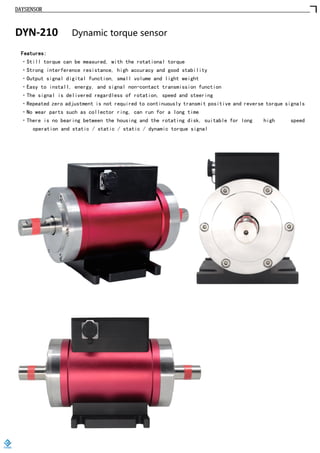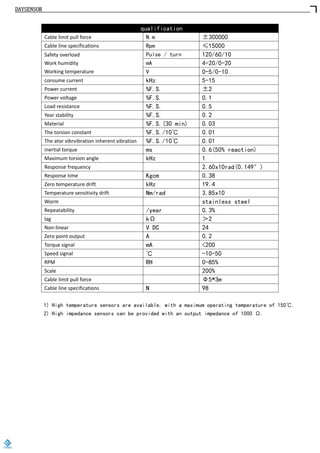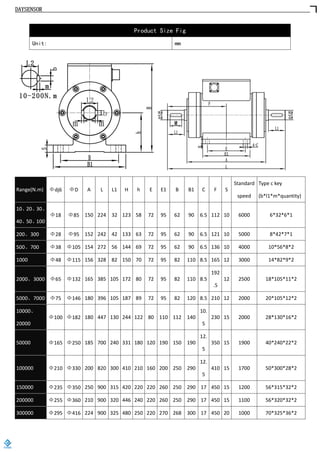DYN-210.pdf
- 1. DAYSENSOR DYN-210 Dynamic torque sensor Features: ¡¤Still torque can be measured, with the rotational torque ¡¤Strong interference resistance, high accuracy and good stability ¡¤Output signal digital function, small volume and light weight ¡¤Easy to install, energy, and signal non-contact transmission function ¡¤The signal is delivered regardless of rotation, speed and steering ¡¤Repeated zero adjustment is not required to continuously transmit positive and reverse torque signals ¡¤No wear parts such as collector ring, can run for a long time ¡¤There is no bearing between the housing and the rotating disk, suitable for long high speed operation and static / static / static / dynamic torque signal https://www.loadcells.store
- 2. DAYSENSOR qualification Cable limit pull force N.m ¡À300000 Cable line specifications Rpm ¡Ü15000 Safety overload Work humidity Working temperature Pulse / turn 120/60/10 mA 4-20/0-20 V 0-5/0-10 consume current kHz 5-15 Power current %F.S. ¡À2 Power voltage %F.S. 0.1 Load resistance %F.S. 0.5 Year stability %F.S. 0.2 Material %F.S.(30 min) 0.03 The torsion constant %F.S./10¡æ 0.01 The ator vibrvibration inherent vibration %F.S./10¡æ 0.01 inertial torque ms 0.6(50% reaction) Maximum torsion angle kHz 1 Response frequency 2.60x10rad(0.149¡ã) Response time Kgcm 0.38 Zero temperature drift kHz 19.4 Temperature sensitivity drift Nm/rad 3.85x10 Worm stainless steel Repeatability /year 0.3% lag k¦¸ £¾2 Non-linear V DC 24 Zero point output A 0.2 Torque signal mA <200 Speed signal ¡æ -10-50 RPM RH 0-85% Scale 200% Cable limit pull force ¦µ5*3m Cable line specifications N 98 1) High temperature sensors are available, with a maximum operating temperature of 150¡æ. 2) High impedance sensors can be provided with an output impedance of 1000 ¦¸.
- 3. DAYSENSOR Product Size Fig Unit: mm Range(N.m) ¦µdj6 ¦µD A L L1 H h E E1 B B1 C F S Standard speed Type c key (b*l1*m*quantity) 10¡¢ 20¡¢ 30¡¢ 40¡¢ 50¡¢ 100 ¦µ18 ¦µ85 150 224 32 123 58 72 95 62 90 6.5 112 10 6000 6*32*6*1 200¡¢300 ¦µ28 ¦µ95 152 242 42 133 63 72 95 62 90 6.5 121 10 5000 8*42*7*1 500¡¢700 ¦µ38 ¦µ105 154 272 56 144 69 72 95 62 90 6.5 136 10 4000 10*56*8*2 1000 ¦µ48 ¦µ115 156 328 82 150 70 72 95 82 110 8.5 165 12 3000 14*82*9*2 2000¡¢3000 ¦µ65 ¦µ132 165 385 105 172 80 72 95 82 110 8.5 192 .5 12 2500 18*105*11*2 5000¡¢7000 ¦µ75 ¦µ146 180 396 105 187 89 72 95 82 120 8.5 210 12 2000 20*105*12*2 10000¡¢ 20000 ¦µ100 ¦µ182 180 447 130 244 122 80 110 112 140 10. 5 230 15 2000 28*130*16*2 50000 ¦µ165 ¦µ250 185 700 240 331 180 120 190 150 190 12. 5 350 15 1900 40*240*22*2 100000 ¦µ210 ¦µ330 200 820 300 410 210 160 200 250 290 12. 5 410 15 1700 50*300*28*2 150000 ¦µ235 ¦µ350 250 900 315 420 220 220 260 250 290 17 450 15 1200 56*315*32*2 200000 ¦µ255 ¦µ360 210 900 320 446 240 220 260 250 290 17 450 15 1100 56*320*32*2 300000 ¦µ295 ¦µ416 224 900 325 480 250 220 270 268 300 17 450 20 1000 70*325*36*2
- 4. DAYSENSOR ÊÜÁ¦Í¼ Load Device | Coupling | Sensor | Coupling | Power Device The bottom is fixed



